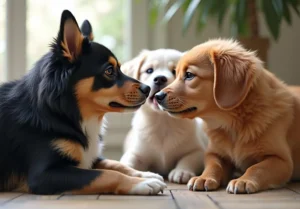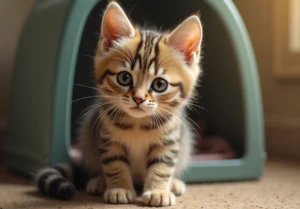Cats are some of the most mysterious creatures on the planet, with their ability to contort their bodies in seemingly impossible ways. One of the most interesting quirks of felines is their liquid-like behavior. But why are cats like a liquid? Let’s find out.
The Physics Behind a Liquid Cat
Have you ever marveled at how a cat can effortlessly squeeze into the tiniest spaces or slink through a crowded room with grace? It’s like they’re made of liquid, defying the laws of physics as we know them. But there’s actually some science behind this behavior.
Cats have a remarkable skeletal structure that consists of flexible bones and an astonishingly agile spine. This allows them to contort their bodies in ways that seem almost impossible. When a cat enters a tight space, it can redistribute its internal organs, compress its ribcage, and flow into the space like a liquid filling a container.
Their muscles also play a crucial role in their liquid-like movements. Cats have powerful, elastic muscles that enable them to twist, bend, and stretch with incredible ease. This combination of bone structure and muscle flexibility gives cats the ability to move in a fluid, liquid-like manner.
So next time you watch your cat effortlessly squish into a cardboard box that seems too small for them, remember it’s all thanks to their remarkable physical adaptations that make them appear as fluid as water.
Adapting to Their Environment
In addition to their physical prowess, a cat’s liquid-like behavior serves a practical purpose in helping them adapt to their environment and stay safe in various situations.
Imagine your cat perched on a narrow ledge high above the ground. Their ability to flow and adjust their body allows them to maintain balance and stability in precarious positions. This liquid-like behavior helps them navigate tricky terrain, escape potential dangers, and even hunt with precision.
Moreover, a cat’s knack for contorting its body enables it to fit into sheltered spots for comfort and security. Whether it’s curling up in a tight corner or squeezing into a cozy hiding spot, their liquid-like movements ensure they can find sanctuary in even the smallest of spaces.
In essence, a cat’s fluidity isn’t just a quirk of their nature; it’s a survival mechanism that allows them to thrive in a world full of challenges and unexpected obstacles. So the next time your feline friend effortlessly slips through a narrow gap, remember they’re tapping into their liquid-like abilities to navigate their surroundings with finesse.
- Stay Clear of Danger: Cats’ liquid-like behavior also helps them avoid potential hazards by swiftly maneuvering away from danger zones. They can slip through tight spaces to escape threats and evade situations that may put them at risk. This adaptability is a key aspect of their survival instincts.
The Role of Bones and Muscles
Did you know that a cat’s skeletal structure and muscular system play a crucial role in their liquid-like movements? Cats have a high number of vertebrae in their spine, which allows for incredible flexibility. Unlike humans who have relatively rigid collarbones, a cat’s collarbone is free-floating, enabling them to twist and squeeze through tight spaces with ease. Their powerful muscles further assist in this by providing the necessary force for such movements. This unique combination of bones and muscles helps cats exhibit their fluid-like behavior.
The Evolution of Flexibility
Cats have evolved over thousands of years to become masters of flexibility, which has proven to be advantageous for their survival and hunting techniques. Through natural selection, cats with more flexible bodies had a higher chance of catching prey and escaping predators. This trait has been passed down through generations, resulting in the agile and supple felines we see today. Their ability to contort their bodies into seemingly impossible positions allows them to navigate various terrains effortlessly and pounce on unsuspecting prey with precision.
- Skeletal Adaptations: Cats’ evolved skeletal structure grants them increased flexibility for hunting and escaping threats.
- Muscular Strength: The powerful muscles in a cat’s body work in tandem with their bones to facilitate their fluid movements.
- Instinctual Behavior: Cats’ innate hunting instincts combined with their flexible bodies make them formidable predators in the animal kingdom.
- Efficiency in Movement: Flexibility enables cats to conserve energy while swiftly navigating their surroundings.
- Adaptive Advantage: Evolutionary changes in cats have fine-tuned their flexibility for survival in various environments.
Uncover more about your feline friends and how their unique anatomy has shaped them into the graceful and agile creatures we know and love.
The Science of Relaxation
Cats have a unique superpower – the ability to relax their muscles like no other animal. This remarkable skill allows them to mold themselves into tight spaces, giving the illusion that they are liquid. When a cat feels comfortable, safe, and content, they can seamlessly flow into whatever shape the situation demands. It’s like they have a built-in relax button that other creatures simply lack.
One fascinating aspect of a cat’s relaxation technique is their bone structure. Unlike humans, whose skeletons are quite rigid, a cat’s bones are more flexible. This flexibility, combined with their extraordinary muscle relaxation ability, enables them to squish, squash, and stretch their bodies in seemingly impossible ways. So, the next time you find your feline friend contorted into a seemingly liquid form, remember it’s all about their superior muscle relaxation skills at play.
Myth Busting: Can Cats Actually Turn Into Liquid?
Let’s debunk the myth once and for all – cats cannot physically turn into liquid. As fascinating as it sounds, cats are not magical shape-shifters. Their liquid-like behavior is simply a clever illusion created by their exceptional flexibility and muscle relaxation capabilities. While they may appear to pour themselves into tight spots or ooze around furniture, they remain solid creatures at their core.
So why do we perceive cats as liquid-like? It all comes down to their impressive adaptability and agility. Cats are skilled at adjusting their bodies to fit into small spaces or adopt unusual positions, giving the impression of liquidity. This ability, coupled with their bone structure and muscle control, allows them to mimic the fluidity of liquids without actually transforming into one.
Remember, the next time your cat seems to defy the laws of physics by squeezing into a tiny box or sliding under a crack in the door, it’s their remarkable anatomy and coordination at work, not magical liquid powers. Stay fascinated by their natural abilities, and appreciate the science behind their seemingly liquid-like behavior!
Cats vs. Other Animals: A Comparative Analysis
When it comes to understanding why cats seem to have liquid-like qualities, it’s helpful to compare and contrast their behavior with that of other animals. Unlike dogs, known for their rigid posture, cats exhibit a remarkable ability to squeeze into tight spaces or contort their bodies to fit any size or shape. This flexibility is reminiscent of the behavior of liquids, which can adjust their form to fit their container.
On the other hand, cats also share similarities with snakes when it comes to their movement. Both animals can move seamlessly and effortlessly, gliding through openings that seem impossibly small. This fluidity in their motions contributes to the perception of cats as liquid-like creatures.
Understanding these comparisons can provide valuable insights into the unique characteristics of cats and how they navigate the world around them. By acknowledging their similarities with other animals, we can appreciate the fascinating nature of feline behavior and their liquid-like qualities even more.
Harnessing the Liquid Power: Tips for Cat Owners
Create Vertical Space : Cats love to perch and survey their surroundings from higher vantage points. Providing tall cat trees, shelves, or window perches can enhance their sense of security and encourage their agile movements.
Offer Hiding Spots : Cats enjoy cozy hiding spots where they can curl up and feel safe. Consider providing comfortable beds, boxes, or tunnels for your feline friend to retreat to.
Engage in Interactive Play : Stimulate your cat’s natural instincts by engaging in interactive play sessions. Use toys that mimic prey movements to encourage your cat’s agility and flexibility.
Maintain a Consistent Routine : Cats thrive on routine, so try to establish consistent feeding times, play sessions, and rest periods. Predictability helps cats feel secure and reduces stress.
Provide Mental Stimulation : Keep your cat mentally engaged by offering puzzle feeders, interactive toys, or rotating their environment to prevent boredom. Mental stimulation is essential for a happy and active feline companion.
By incorporating these tips into your cat care routine, you can create a safe and stimulating environment that encourages your feline friend to exhibit their liquid-like behaviors to the fullest. Understanding and appreciating their unique qualities will deepen the bond between you and your cat.
Curious Cat Trivia
Did you know that one of the reasons cats are like a liquid is because they possess a unique ability to squeeze into tight spaces like liquids do? This is due to their flexible spine and bones, allowing them to contort their bodies to fit through openings that seem impossible for their size. Cats can also change the shape of their bodies to fit comfortably into small spots, just like liquids conform to their containers. Another fascinating fact about cats is that they have a natural instinct to seek warmth, which is why you might find your feline friend curling up in the sunniest spot in your home. This behavior is reminiscent of liquids, which also tend to flow toward heat sources. Keep these interesting tidbits in mind next time you marvel at your cat’s liquid-like behavior!
Cat Astrology: What Your Cat’s Behavior Says About Their Personality
Have you ever noticed how differently each cat behaves, even when faced with the same situation? This individuality extends to their liquid-like behavior, which can provide insights into their unique personalities. Cats who effortlessly flow into tight spaces may be more adventurous and curious, with a desire to explore every nook and cranny. On the other hand, cats who prefer to lounge in open spaces might have a more laid-back and relaxed personality. Observing your cat’s liquid-like tendencies can give you a glimpse into their inner world and help you better understand and connect with them. Remember, just like liquids, cats come in all shapes and sizes, each with their own distinct personality traits to uncover.
Cat Personality Traits Revealed Through Liquid-Like Behavior:
– Adventurous: Cats who fluidly move into small spaces are often more daring and curious.
– Relaxed: Cats who prefer open spaces and lounging are usually more laid-back and easygoing.
– Cautious: Cats who carefully navigate around obstacles and tight spots tend to be more cautious and observant.
– Playful: Cats who delight in squeezing into odd places for fun are likely to have a playful and mischievous personality.
Remember, understanding your cat’s liquid-like behavior can offer valuable insights into their unique personality traits, helping you build a stronger bond with your feline companion.
Alex, a passionate animal lover, has experience in training and understanding animal behavior. As a proud pet parent to two dogs and three cats, he founded AnimalReport.net to share insights from animal experts and expand his knowledge of the animal kingdom.




